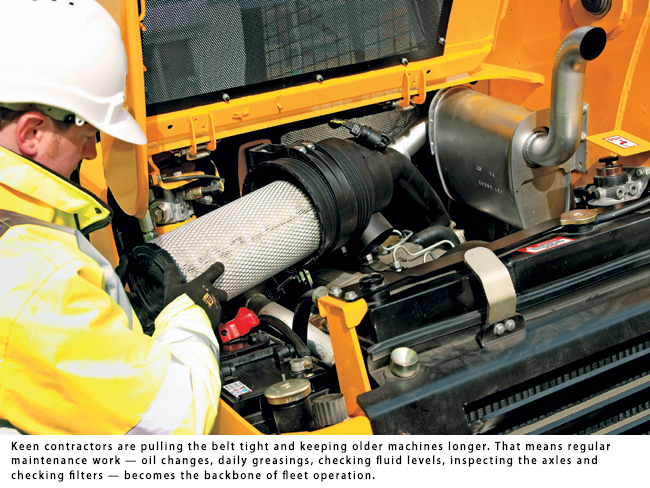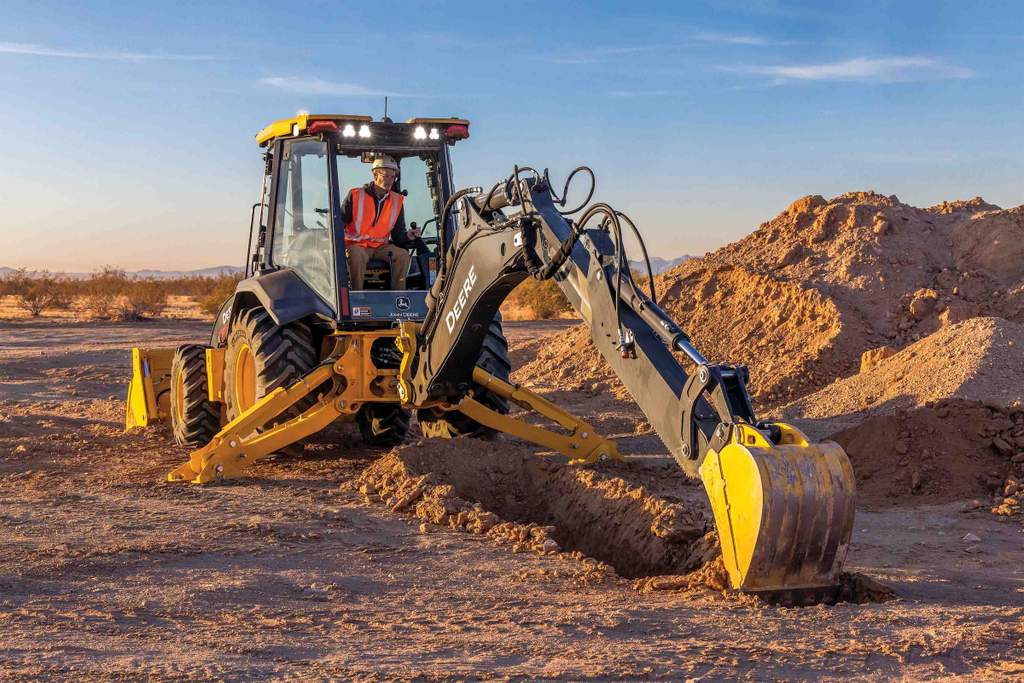Up and Running
As forecasted, 2009 was a tough year for contractors and the heavy equipment industry. Because they depend greatly on increased consumer spending, new home starts and infrastructure improvements, contractors and the manufacturers that supply them with equipment like skid steer loaders, telescopic handlers, backhoes and excavators have felt the pinch more than just about any other economic sector.
As we reach the halfway point of 2010, the economy shows signs of improvement. However, many contractors are continuing to play it safe by reducing overhead, scaling back on their number of employees and being very conservative when it comes to new equipment. According to Mike Werner, vice president of customer support operations at equipment manufacturer’s JCB North American headquarters in Savannah, Ga., his company has seen evidence of this situation first-hand.

“For a number of reasons, many contractors are holding on to their equipment longer in today’s market,” Werner says. “Over the past year or so, the credit crunch has made it a challenge to secure financing for projects. Customers may not have the money to spend on improvements to their properties. This leads to lighter workloads and machines that aren’t getting used nearly as much.”
Within the heavy equipment industry, machine life is measured in two primary ways — years old and service hours. In most cases, the service hours measurement is a more accurate indicator of the amount of wear a machine has experienced. However, the number of years a machine has been around does have an effect on its residual value. While some contractors keep a machine three to five years or around 5,000 to 8,000 service hours, others have made it a standard practice to trade machines religiously at three years or 3,000 hours to get a higher resale or trade-in value. Now, those same contractors are keeping their equipment longer because they simply can’t afford to sell it.
“Just like what we’ve seen in the housing market with home prices dipping below market value, the price of used equipment has gone down because of weaker demand,” Werner explains. “Many owners of heavy equipment are electing to keep their machines longer and wait out this soft market rather than sell them or trade them in for less than they’re really worth.”
Beyond the Border
This trend toward keeping machines longer is not limited to contractors in the United States. Jack Riley, service manager for JCB dealer CERVUS of Edmonton, Alberta, Canada, echoes Werner’s observations.
“At our dealership, we’ve absolutely seen signs that people are holding onto their equipment,” Riley says. “For example, if we’re talking about an excavator, it’s typical for a construction company to keep it for about three years or 5,000 service hours before trading it in for a new machine. Now, because they don’t want to invest in a brand new machine, we’re seeing people fix problems that were formerly small annoyances that they’d put off because they were so busy.”
According to Riley, however, the economic outlook for construction equipment isn’t all gloom and doom. While some construction business owners may feel that they don’t have enough work just yet to justify the purchase of a new machine, many are reporting an upswing in the number of project bids coming their way.
“Our customers are finally starting to see an increase in the number of jobs they’re getting,” Riley explains. “But since the economic outlook has been so tight, that doesn’t mean they’re necessarily ready to buy new equipment. Instead, they want to make sure their current equipment is in good working condition to tackle those new projects.”
At CERVUS — and many other heavy equipment dealerships throughout North America — this situation
translates to a service center that’s experiencing a surge in repair work, from engine and transmission replacement to full check-ups and inspections.
At Your Service
As expected, keeping an older machine on the job may save money, but it also offers up its own challenges. Many owner-operators perform their own maintenance work — oil changes, daily greasing, checking fluid levels and inspecting the axles — while letting their dealers handle the actual servicing of the machine.
However, the fact that owners are holding onto their equipment for longer periods of time brings up service issues with which they may not be familiar, having traded in their equipment long before it required service in the past.
“Owners who used to trade in their machines often need to be aware of the importance of additional servicing at their local dealer after their equipment is over three years old or so,” Werner says. “They may have never had to have their powertrain, transmission or axles serviced. Hydraulic relief valves should also be checked for pressure. Brake pads and tires typically need to be replaced after a few years of steady use and gauges should also be monitored for accuracy.”
Werner went on to explain that while regular dealer servicing is extremely important, older machines can also benefit greatly from a few additional maintenance activities that owners can handle on their own. These activities include regularly inspecting for hose damage, hydraulic leaks, tire wear and pins and bushings that need grease. Cylinder rods should also be checked for damage and periodic greasing.
“The damage incurred by not maintaining hoses, tires and hydraulic leaks will eventually lead to one thing that most owners cannot afford right now, and that’s downtime,” Werner says. “If a hose blows in the middle of a job, that job is at a standstill until the machine can be repaired. That means operators and laborers will be sitting around waiting to start back up, and they need to be paid regardless.”
There’s another obvious repercussion of overlooking important maintenance and service work — huge repair bills. Letting components wear prematurely by simply not changing the oil or greasing pins and bushings can shorten the components’ wear life by as much as 50 percent. This can lead to service bills that are twice as large or the need to repair or replace parts in half the usual amount of time.
Looking Forward
Since the economy appears to be recovering from its low point in 2009, is it likely that contractors will soon revert back to the practice of trading in machines after only a few years? While no one can say for sure, Riley is doubtful. He attributes the increased demand for equipment repairs and service in large part to a greater emphasis on operational efficiency. In his opinion, because more owners are recognizing the value of an asset that’s paid for or nearly paid for, they’re repairing their machines and keeping them in top condition rather than taking on a new payment.
“At the end of 2008, management at CERVUS anticipated a very significant dip in the market during 2009,” Riley says. “We formulated a plan to look at every nook and cranny of our dealership to make sure it was running as efficiently as possible. I think, regardless of the number of projects they currently have, many of our customers also streamlined their operations, and they are continuing to look for ways to conserve cash.”
While it’s expected that contractors will continue to limit spending and be cautiously optimistic in the months ahead, some say that the industry outlook is definitely improving.
“I think this emphasis on keeping equipment longer will really offer some momentum to the service portion of our industry,” Riley adds. “People who otherwise weren’t concerned about repair and service are now seeing its significance in their return on investment. I think this is just the beginning of a whole new approach to purchasing, maintaining and selling equipment.”
Lynette Von Minden is public relations counsel for Swanson Russell, based in Lincoln, Neb.
The WEXSMART Way
Keep Your Vehicles on the Road and Employees on the Job
Wright Express is offering WEXSMART, a wireless vehicle tracking and diagnostics system — also referred to as telematics — as a complimentary product to customers joining the Wright Express fuel card program. With Wright Express’ nationwide network coverage, the power of your fuel card is increased to include the ability to obtain up-to-the-minute reports on the location, speed and actual operating condition of your vehicles. SIM cards and encryption features protect your company’s data, making sure it is sent safely and securely to you.

Once installed, WEXSMART communicates with your vehicle’s internal computer sensors that monitor performance and detect problems. The WEXSMART system interprets vehicle diagnostic data and transmits the data back to you over your service provider’s wireless network. WEXSMART will then immediately alert you of any vehicle problems through your online account. And through continual analysis of your vehicle’s performance as well as maintenance notifications sent based on predetermined system readings, you can proactively identify and repair diagnostic problems, improve maintenance and extend the life of your vehicle.
Features abound and include: nationwide coverage; two-minute GPS location updates; vehicle tracking history; landmarking/geofencing; hierarchical grouping; engine problem alerts; a full reporting suite; and speed reporting.
The Mission: Efficiency
Dealer Reduces Mechanic’s Truck Service Time with Integrated Power Source
By Ben Peotter
Brandeis Machinery and Supply, a construction and mining equipment dealer based in Kentucky and Indiana, recently analyzed 170,000 work orders spanning over 10 years in order to better understand how field service technicians used their trucks. In addition to equipment use and field practices, Brandeis examined idle times and the resulting effects on engine wear and fuel use.
“We put together a service initiative team to identify potential inefficiencies,” says Todd Coffey, corporate service manager, Brandeis Machinery and Supply. “The dilemma we always ran into was that I’m running anywhere between a 200- to 250-hp engine [to power the mechanic’s tools], where a far lower horsepower will take care of it. That’s just not good.”
This led Brandeis to explore options for running air tools, crane hydraulics and power tools in the field without relying on a power take-off (PTO) system, thereby allowing field service technicians to turn the truck off while working. Brandeis worked with Miller Electric Mfg. Co. to install the new EnPak Mechanic Series, a truck-integrated power system run by a 27-hp engine that includes a rotary-screw air compressor, hydraulic pump and a generator.
After six months of data, the results speak for themselves: a 55 percent reduction in idle time; a 36 percent reduction in overall engine hours; and preliminary fuel-savings estimates that conservatively pay for the system’s premium on its own. The expectation of a longer service life and longer service intervals due to these efficiencies brings overall payback to under two years.
“In the six months we’ve been running it, the off season and the economy have put us in a position where we’re probably not running the truck as hard,” says Coffey. “The numbers that we have gotten back are very conservative compared to what it will be when things pick up, but we’re possibly talking $750 to $1,000 a year in fuel savings. And that is particularly significant when I look at my fleet and I start talking about putting an EnPak on 60 trucks.”
Ben Peotter is engineering manager for the mobile utility group of Miller Electric Mfg. Co., based in Appleton, Wis.






Comments are closed here.